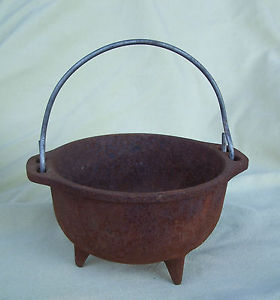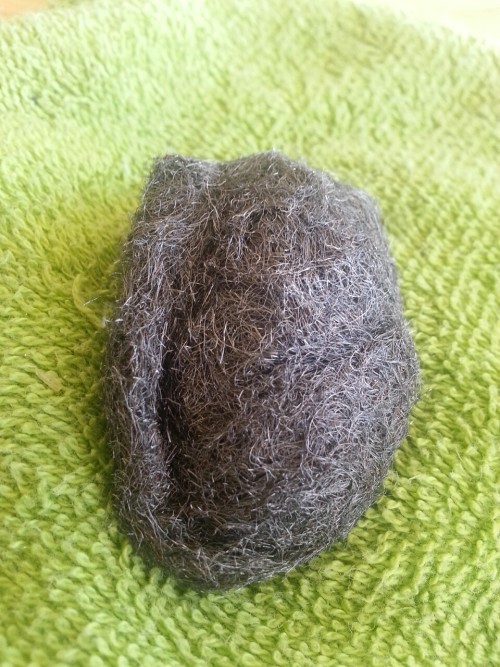green-mystic: How to Restore Cast IronYesterday at Goodwill I found a tiny cast iron cauldron that u
green-mystic: How to Restore Cast IronYesterday at Goodwill I found a tiny cast iron cauldron that unfortunately had become extremely rusted from misuse. That’s probably how it ended up on the shelf of a thrift store, and since it was half price (I’d gotten it for $2.50) I knew it’d been sitting there for awhile. I come across a lot of cast iron for real cheap, and the reason why it’s cheap is the rust. Fortunately I know that rust doesn’t mean an item can’t be used—it simply needs to be restored. Few people realize that this easy process can be done at home in your own oven. Iron is durable, though it requires specific care.Don’t ever try to cook on or eat off a rusty pot, skillet or cauldron. Instead, take a day to restore it—and learn to handle it properly for the future, too.~Materials to Restore Cast Iron~ Steel Wool (shown above on the green towel) Cooking oil Paper towel (a coffee filter also works in a pinch) Oven that can reach at least 450F Soap and water Dry towel Aluminum foil ~Procedure~ Remove the rust. Using the steel wool and some warmish water, scrub the piece completely. You may wish to wear gloves, and depending on the amount of rust, this process may be labor intensive and take awhile. For an even cure later, it’s best to completely remove black layer, which is the original seasoning. Steel wool will accomplish this, but you may go through two or three pads so purchase accordingly. I’ve gotten away with using the soap pads from SOS (the soap won’t hurt the process) which you can find at the grocery store. If the rust is bad, though, either go get industrial strength steel wool or take the piece to get sandblasted. Clean and dry. Wash the piece with warm soapy water to completely remove any remaining residue and steel filings that may come off your pad. Dry it thoroughly! Water is bad for the next process. Also at this point inspect the piece to make sure there aren’t any cracks, exceptionally thin spots or other deficiencies. Apply the seasoning. Using a paper towel or coffee filter buff your chosen oil into the iron. I usually do two curing sessions and I apply the oil over the whole piece (do not neglect the bottom!) As far as oils go, my oil was picked for its magickal correspondences since this is a magickal piece—for food purposes, you can use anything from canola oil, vegetable, rapeseed, flax or even animal fat oils. I saw my mum once season one of her skillets with bacon grease in a campfire! Rub it in well, and remember it’s also better to do a thinner coat, and then a second coat later, rather than one thick coat. <3. Turn your oven OFF. This step is crucial. Never—NEVER—subject cold iron to hot surfaces, or hot iron to cold surfaces unless you want to see an iron explosion with the potential for iron projectiles. (No, but really you can crack a skillet in half pouring cold water into a hot pan.) Set your oven racks towards the center, with one very close underneath the other. On the lower rack put some aluminum to catch anything that will drip from your cast iron. Place your piece on the upper rack upside down. This will prevent oil from pooling in the bottom as it melts, thus giving you an uneven seasoning. Rather, excess oil will drip off into your aluminum. Turn the oven on to 450-475F. 475 is ideal. I’ve seen people do it at 400, but it will take longer and unless you’ve applied a very thin coat, you’ll end up with sticky pieces. Below 400 will not work, in my experience. A lot of tutorials online seem to call for 200F, even 325F. At those temperatures, you’ll need to leave it in there a day or two and then it still might turn out sticky. Refer to the picture above where the cauldron looks like it has a layer of oil dripping up the side. You’ll get that too if you take it out too soon (as I did). I’ve seen people do it at 500F too, but I’ve never found that heat necessary. Alternatively, you can also do this process in a campfire, just make sure it’s up above the coals and away from direct flame. Let it roast for 2-3 hours minimum. It will make your house smell! Depending on the oil you used it may make it smell amazing. It will also make your house hot. I tend to do most of my seasoning in the winter time, then just huddle in the kitchen with tea, a blanket and a book. When you think it might be done, turn the oven off. DO NOT REMOVE THE PIECE IMMEDIATELY. Sudden temperature change is bad for iron, remember! Not only can I guarantee you will burn yourself, but I’ve also burnt the hell out of one of my pretty woven hot pads that I use when I bake. It was sad, but the second degree burns and smouldering oven mitts were sadder. :( Let the oven and cast iron cool completely. Then remove. Repeat the process once or twice more for best results, but you can officially use your stuff after the first seasoning (few people recommend it though). <3. ~How to Prevent Rust~Here are some quick tips to prevent having to annoy your roommates in the future by burning a 475F oven for 3 hours for multiple days in a row (as I currently am): Do not soak cast iron in water ever. Do not wash cast iron in water unless absolutely necessary. If washing becomes necessary, wash immediately, dry completely and immediately. Do not EVER put your cast iron in a dishwasher. If you fill up you cauldron with strange black liquids for scrying, dry completely and immediately. Regular seasonings will help withstand rust. I usually do one round of seasoning on my skillets any time I need to wash them (about two-three times a year). A good seasoning also helps make sure you don’t need to wash it so often. Do not touch your roommate’s cast iron. Ever. It’s not dirty. Seriously. I had a roomie once decide my mum’s handed down skillet was dirty and scrub it so hard she completely took off a five year old seasoning. And then threw it in the dishwasher for good measure. Fucking bitch. I wanted to hit her with it, because that was all it was good for after that. Otherwise, enjoy, and please ask questions if anything isn’t clear. <3. -- source link
Tumblr Blog : green-mystic-deactivated2014083.tumblr.com
#skills#homestead#homesteads#homesteading#homesteadingskills#homesteading skills#cleancastiron#restorecastiron#seasoncastiron




